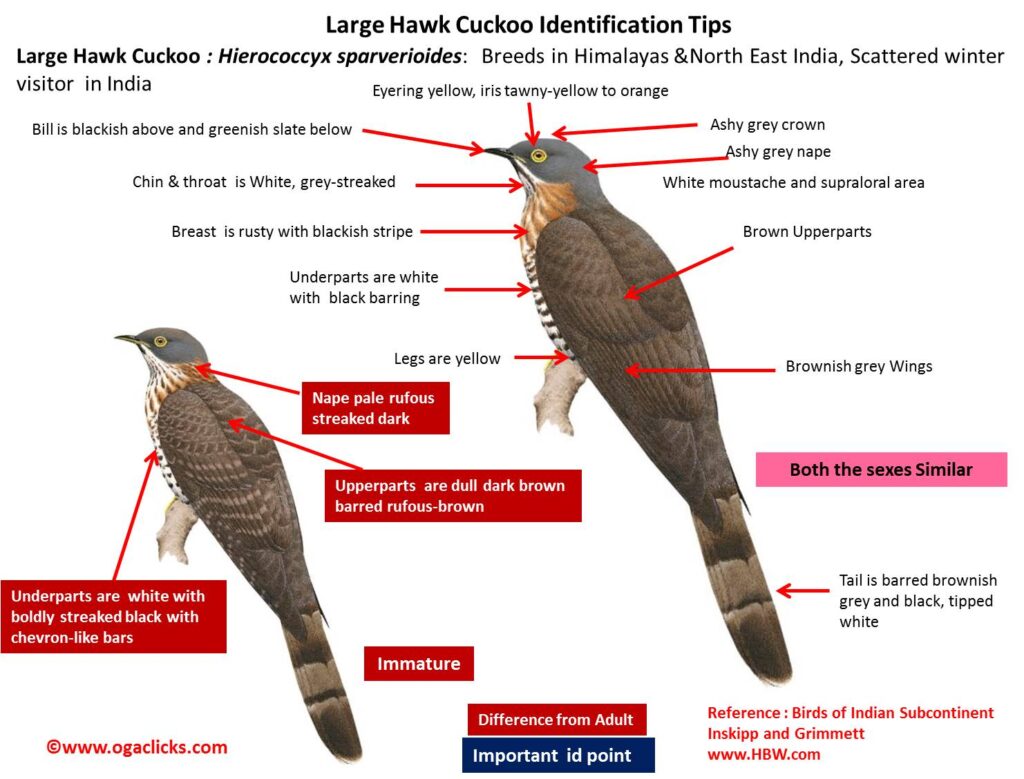
Large hawk Cuckoo Hierococcyx sparverioides
Etymology:
- Hierococcyx : hierax- hawk ; kokkux –cuckoo.
- Sparverioides : sparverius- Sparrowhawk ; oides –like { Hawk Like}
Vernacular Names: Pun: Wadda papiha, Lepcha: Nimbin piyal, Nepal: Bada bharao
Distribution in India: Resident of Himalayas, Naga Hills, Manipur and Meghalaya. Winters mainly from NE India to South West & South East Peninsular India
Description: Size of 38–40 cm; wt. of 116–163 g. The largest of hawk-cuckoo. The adult dark morph is brown above, ashy-grey on crown, nape and neck, tail is barred brownish grey and black, tipped white, with strongly barred remiges. The underparts are white with grey-streaked throat, rusty with blackish stripes on upper breast and broad black barring on flanks and belly. The eyering is yellow, iris is tawny-yellow to orange, bill is blackish above and greenish slate below, and legs and feet are yellow to orange-yellow with dirty lemon-yellow soles. The pale-morph adult is paler grey above than dark morph, with even paler grey and rufous fringes, with rufous and whitish throat, upper breast is barred rufous and white, lower breast to belly and flanks are creamy white with rufous bars and chevrons, and vent and undertail-coverts are white. The subadult has top of head as grey-bronze, upperparts and wings are dull dark brown barred rufous-brown. It has white to pale buffish underparts boldly streaked black with chevron-like bars on flanks. The juvenile is barred rufous and brown above, forehead is grey, brown crown is spotted rufous, nape is pale rufous streaked dark, tail is barred rufous and black. The underparts are white variably tinged buffish, streaked with blackish or dark brown teardrops, and little or no rusty on breast. The iris is greyish brown, bill is brownish black with culmen tinged olive, and has a yellow gape.
Habitat: It is found in deciduous and evergreen wooded areas, oaks, pine woods, mixed coniferous and broadleaved forests ,open forests, plantations, tall second growth, mangroves, wooded gardens and scrub in open country. It breeds at 900 m–3500 m.
Food Habits: It eats Insects, mainly caterpillars, Hemiptera, crickets, grasshoppers, beetles, bugs, roaches, ants and spiders; berries and birds’ eggs. It forages solitarily and quietly in trees, remains in canopy and midstorey, often remaining virtually motionless for long periods.
Breeding Habits: They breed in Apr–Jul. They are brood-parasitic. The hosts in India are Streaked Spiderhunter (Arachnothera magna), Little Spiderhunter (A. longirostra) and Nepal Shortwing (Brachypteryx leucophrys),